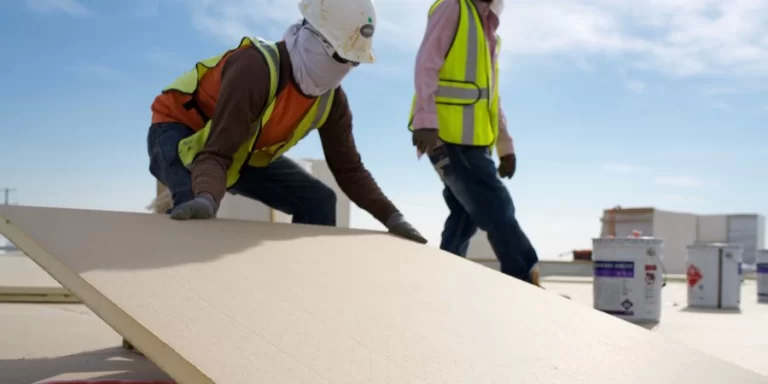Sustainable Rooftop Development
Roofing projects, while essential for maintaining the integrity of buildings, can have significant environmental implications. The materials used, waste generated, and emissions produced during roofing activities can all impact the environment and surrounding ecosystems. Various environmental regulations have been established to address these concerns to ensure that roofing projects are conducted in an environmentally responsible manner. This article will delve into the critical environmental regulations governing roofing projects, highlighting their importance and implications.
The Environmental Impact of Roofing Projects
Before delving into the regulations, it’s crucial to understand the environmental impact of roofing projects. Roofing activities can result in the emission of pollutants, depletion of natural resources, and generation of waste that can harm ecosystems and human health. The choice of roofing materials, disposal methods for old materials, and construction practices all play a role in determining the overall environmental footprint of a roofing project.
One of the primary concerns is the emission of volatile organic compounds (VOCs) and other air pollutants during roofing installation. These pollutants contribute to air quality degradation and can have adverse health effects on both construction workers and local residents. Additionally, improper disposal of roofing waste, such as old shingles, can lead to land and water pollution.

Key Environmental Regulations
To mitigate the environmental impact of roofing projects, various regulations have been put in place by government agencies at different levels, ranging from local to federal. These regulations encompass a wide range of aspects, including air and water quality, waste management, and sustainable practices. Let’s explore some of the key regulations in these areas:
- Clean Air Act (CAA): Enforced by the U.S. Environmental Protection Agency (EPA), the Clean Air Act aims to control air pollution and regulate emissions of hazardous air pollutants, including VOCs. Roofing activities that involve the use of adhesives, sealants, and coatings are subject to VOC limits set by the EPA.
- Resource Conservation and Recovery Act (RCRA): The RCRA is focused on proper waste management, including the handling, transportation, and disposal of hazardous waste. Roofing materials, such as asbestos-containing shingles, are considered hazardous waste and must be managed according to RCRA regulations.
- National Emission Standards for Hazardous Air Pollutants (NESHAP): NESHAP standards are established under the Clean Air Act to regulate emissions of specific hazardous air pollutants, including asbestos. Roofing projects involving asbestos-containing materials must adhere to strict guidelines to minimize the release of asbestos fibers into the air.
- Stormwater Management: Many roofing projects involve the removal of old materials and the application of new roofing materials, both of which can generate stormwater runoff containing pollutants. Stormwater regulations require proper management and containment of runoff to prevent it from entering nearby water bodies.
- Energy Codes and Standards: While not exclusively environmental, energy codes and standards often impact roofing projects. Regulations related to energy efficiency and insulation can influence the choice of roofing materials and installation practices to reduce energy consumption.
- Local Regulations: In addition to federal regulations, local municipalities may have their own zoning ordinances, building codes, and environmental regulations that roofing projects must comply with. These can include requirements for green roofing, reflective roofing materials, and overall sustainable building practices.
Implications and Challenges
While these regulations are essential for safeguarding the environment, they can present challenges for roofing contractors and property owners. Adhering to strict emission limits, managing hazardous waste, and implementing proper stormwater management practices can increase project costs and complexity. Contractors must invest in training, equipment, and waste disposal processes that meet regulatory standards.
However, these challenges should not overshadow the long-term benefits of complying with environmental regulations. By adopting sustainable roofing practices, contractors can reduce their carbon footprint, minimize health risks for workers and residents, and contribute to the overall well-being of the community.
The Path to Sustainable Roofing
In response to the growing concern for environmental impact, the roofing industry is shifting toward more sustainable practices. This involves not only complying with regulations but also embracing innovative technologies and materials that reduce the overall ecological footprint of roofing projects.
- Green Roofing: Green roofing involves the installation of vegetation on rooftops, which provides insulation, reduces stormwater runoff, and improves air quality. While not suitable for all projects, green roofing can significantly contribute to urban sustainability.
- Cool Roofing: Cool roofing materials reflect sunlight and absorb less heat, reducing the urban heat island effect and lowering energy consumption for cooling. These materials often comply with energy codes and contribute to overall energy efficiency.
- Recycled and Renewable Materials: Using roofing materials made from recycled content or renewable resources can reduce the demand for virgin materials, conserving natural resources and reducing waste generation.
- Waste Recycling and Disposal: Properly sorting and recycling roofing waste, such as asphalt shingles, metal, and wood, can divert significant amounts of waste from landfills. Some regions even offer incentives for recycling roofing materials.

Roofing projects are an essential aspect of building maintenance and construction, but they also have a notable environmental impact. Environmental regulations governing roofing activities are vital for safeguarding air and water quality, conserving resources, and mitigating pollution. While complying with these regulations can pose challenges, the roofing industry’s shift toward sustainable practices holds promise for a greener future. By embracing green and cool roofing technologies, utilizing recycled materials, and prioritizing waste management, roofing projects can contribute to both structural integrity and environmental well-being. It is essential for all stakeholders, including contractors, property owners, and regulators, to collaborate in ensuring that roofing projects align with these regulations and advance the cause of environmental stewardship.





























